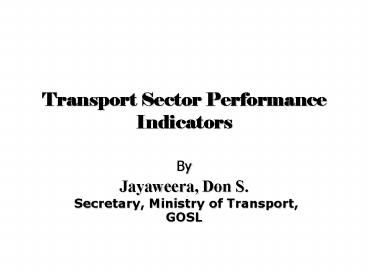Transport Sector Performance Indicators - PowerPoint PPT Presentation
1 / 27
Title:
Transport Sector Performance Indicators
Description:
modernizing the railway by a reform within public sector ... Railways. Steam Locomotives 2. Locomotives 82. Rail Cars 2. Diesel Hydraulic Power Unit 56 ... – PowerPoint PPT presentation
Number of Views:58
Avg rating:3.0/5.0
Title: Transport Sector Performance Indicators
1
Transport Sector Performance Indicators
- By
- Jayaweera, Don S. Secretary, Ministry of
Transport, GOSL
2
Goals of the workshop
- Facilitation to the management of various
sub-sectors so that they can effectively deliver
transport services and transport infrastructure
cost effectively by optimum solutions - Adjust the policies through monitoring and
reviewing of the sector performance in respect of
its contribution to the implementation of agreed
national policies and - Provision of better insight into Local, National,
Regional and Global perspective of transport
activity and trends
3
(No Transcript)
4
Economic, Social and Environmental Indicators
- Per Capita GDP US 947 -2003
- Population 19.252 million
- Population Growth 1.3
- Population Density 307 persons per sq. km
- Gini coefficient 0.48
- Literacy Rate 90.1 (92.5 male, 87.9 female)
5
(No Transcript)
6
Size of the Transport Sector within the Economy
- 8.3 of the GDP is from the Transport Sector
2003 - Per Capita GDP US 1028
- Contribution of transport sector ranging from 6
to 11 during last decade - Total direct employment is 745,000
- Estimated value of fixed assets - Rs. 260 billion
(US 26,000 million) - Estimated total losses - 45 of perishable
vegetables and 35 of paddy - Other product loss is 28
7
Size of the Transport Sector within the Economy
- Average annual expenditure is Rs. 34 billion
(Equivalent of US 3,400 million) - 6 to 9 of the Government budget for transport
sector - Total economic loss due to transportation is
estimated as Rs. 38 billion - Total economic loss due to non-existence of
accessibility is estimated as Rs.64 billion per
annum - Note Urban traffic congestion, produce not
reaching markets, transportation losses,
time lost due to poor access to the services had
been taken for calculation
8
Objectives of the Current Transport Policy (Local
and Global)
- Enhancing connectivity closer to transport and
information division between poor communities and
dynamic markets - Revitalizing rural development
- Promote development of small and medium scale
enterprises - Increasing employment and mainstreaming poverty
reduction objectives in sectoral development
strategies and - Incorporating participation and empowerment in
approaches aimed at assisting poor regions
directly.
9
Current Transport Strategies
- Upgrading port network
- Building a national highway and an integrated
road network - Enhancing the performance of the bus system
- Modernizing railway
- Improving access to telecommunication facilities
- Bringing internet to rural community.
10
Thrust Areas of the Transport Policy
- rural access roads and rural transport services
- Public Service Obligation of Transport Services
- Pricing of transport services and infrastructure
- Welfare effects of the transportation
- Accessibility of urban and rural poor for
services and employment - Environmental effects and productivity
- Quality and effectiveness of transport services
and infrastructure including public cost
minimization
- building a modern road network
- providing safe road network
- enhancing the most important bus transport
system and - modernizing the railway by a reform within public
sector
11
Transport Infrastructure
in Kms
- Roads
- Total network 108,000
- National Roads 11,236
- Provincial Roads 15,450
- Local Authority Roads 74,500
- Forest, Wiled Life, Irrig. Estate 8,000
- Approximately 2000 villages do not have proper
accessibility which is - equivalent to 5 of the total human settlements
in the country
12
Transport Infrastructure
Length Of Track Open For Traffic (km) as on
31.12.2002
- Railway Total Network - 1,524 km
- Length of Track opened for Traffic as at May 31,
2003. - Single Line 1,112.02
- Double Line 120.18
- Third Line 13.37
- Total 1,246.00
- BG Yard Line 279.00
- Total BG Track 1,524.00
- Length of Track not in Operation 295.57 km
- 134 villages connected only by inland water ways
and causeways (North East of the Country)
13
Transport Services Rolling Stocks as at May,
2004
- Road Sector Active Fleet 1,274,000
- Private sector buses 17,840
- Cluster Buses 3,900
- Motorcycles 450,000
- Three Wheelers 164,000
- Lorries 86,740
- Motor Cars 138,345
- Dual Purpose/ Vans/ 4WDs 176,348
14
Table 1 Number of villages without access to
all whether roads
National Road Network and Railway Network with
transportation nodal points.
15
Transport Services Rolling Stocks
- Railways
- Steam Locomotives 2
- Locomotives 82
- Rail Cars 2
- Diesel Hydraulic Power Unit 56
- Coaches 1,260
- 234 villages are accessible only by rail track in
the Island
16
(No Transcript)
17
Growth of Transport Sector and Economy
18
(No Transcript)
19
Source Census of Population and Housing 2001,
Dept of Census and Statistics
20
Expenditure and Outputs
Source SLR, MOTHCA, and AMTRAC
21
Passenger and Freight Market Distribution
22
Data gaps identified and tentative solutions
- Local Authority and Provincial Council level data
for road conditions - Supply Demand of buses at provincial and local
levels - Household expenditure on transportation (on
regular basis) - Data on maintenance of roads (routine, and
periodic) - Vehicle emission data.
23
(No Transcript)
24
(No Transcript)
25
(No Transcript)
26
Data gaps identified and tentative solutions
- Collection of random sample data for road
conditions - Case study for operated vehicle km for private
motor vehicles - Sample survey for vehicle occupancy
- Expenditure for transport from household surveys
used to estimate data for non-available years - Need capacity building at grass root level
27
Thank you !!































